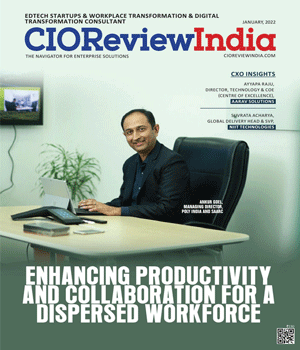
Transforming employee experience through the deployment of invisible apps
Prasad Ramakrishnan, CIO of Freshworks
 People have questions and they want instant answers. Long gone are the days of opening a web browser to conduct a search – be it on your laptop or even your mobile phone. Today, when we have a question, we simply shout out two simple words – ‘Hey, Siri’ (or Alexa, or Google). And to our bemusement, they answer! This instant gratification in our personal lives isn’t enough, we want this easy, seamless and invisible experience in our work lives, too.
People have questions and they want instant answers. Long gone are the days of opening a web browser to conduct a search – be it on your laptop or even your mobile phone. Today, when we have a question, we simply shout out two simple words – ‘Hey, Siri’ (or Alexa, or Google). And to our bemusement, they answer! This instant gratification in our personal lives isn’t enough, we want this easy, seamless and invisible experience in our work lives, too.
Out of sight, out of mind
Today, employees do not want to feel tethered to a business process or a business application. This is where invisible apps come in. The concept of invisible apps is not really new – they’re a
facade layer on top of existing business applications. Invisible apps enable employees to skip steps and interact with an application lurking behind the scenes without even knowing they are doing so. An early example of this is when an employee sends an email to the service desk to create a ticket, rather than logging into the service desk and opening a ticket themself. Or getting approval of purchase requisitions and expense reports via email, while a finance application is working in the background.
Visible business benefits from an invisible source
The consumerization of IT has led to an increased expectation of an omnichannel experience in everything we do. The emergence of AI, NLP and other such technologies have made it possible to transform the employee experience – and it’s perfect timing because employees are looking for simplicity when it comes to having their requests met and getting the answers they need.
Creating a friction-free implementation of transparent processes using invisible apps can greatly benefit an organization. While adoption is one of the most critical challenges in any organization, removing the friction from the employee experience can help companies increase adoption of their digital transformation initiatives and ultimately improve employee engagement.
Organizations also benefit from having their business data and interactions recorded in a system of record instead of in an email when they deploy invisible apps. This enables businesses to measure what is working well and what is not, which in turn provides information required to kick-off future digital transformations.
On the flip side, employees benefit as well. Frictionless processes can remove stress and work-around steps to get the job done. Implementation of using invisible apps will not only encourage a greater adherence to processes, but actually delight employees by having their request handled in an efficient and painless way, leading to better business outcomes.
For example, rather than logging in to the human capital management app to see their vacation balance, employees can simply use Slack or Teams to ask and get an immediate response.
Invisible apps at work
While there are many ways invisible apps can help streamline employee efforts, some commonly found examples in the workplace include a one-stop way for employees to request virtual credit cards, or an ITSM portal to ask for help with technology issues.
Streamlining multiple help desk applications into one single window app is yet another way of making apps invisible. From an end-user perspective, when they need help they go to one single window (help window) and the magic genie behind the scene routes the ticket to the appropriate servicing organization, be it HR, facilities, finance, travel desk, marketing or IT. This elevates the employee experience.
Deployment of chat-based interfaces to applications is another way companies can deploy invisible apps. Most applications have native integration to Slack or Teams which makes it possible to make the app truly invisible. Many apps also have a rich REST API set which can be used to custom build these interfaces, if a native integration does not exist.
Robotic process automation bots can bring data from one business process to another without the user needing to even know that it is happening. Deploying a Slack BOT to show the key metrics that matter for the various roles in the company removes the need for users to login to their business intelligence portal. Additionally, information is pushed to the user which makes the goal of actionable intelligence a reality.
One size doesn’t fit all
The simplification of your employee experience is a journey and a one-size fits all approach doesn’t work. To enhance the employee experience through deploying invisible apps, businesses need to understand their user base and adapt their strategy to what works best for their employees.
For example, a global company may automatically connect employees to the appropriate corporate wifi network whenever they walk into an office location. Or perhaps they’ll enable employees to throw passwords to the side and use a seamless single sign-on experience for employee-related services.Regardless, invisible apps are always there behind the scenes and can help to enhance the employee experience.
Afterall, employees crave to have the same seamless and invisible simplicity they experience from technology at home in their workplace – even if it entails asking Alexa, Siri or Google to take on some of the workload!
CIO Viewpoint
Why Foolproof Facial Recognition Is Key Against...
By Joseph Sudheer Thumma, Global CEO & MD, Magellanic Cloud
National Technology Day 2025: Powering Progress...
By CIOTech Outlook Team
Aligning IT Roadmap with Business Objectives: A...
By Subhash singh Punjabi, CISO & Head Enterprise Architecture, Deepak Fertilisers & Petrochemicals Corporation Ltd
CXO Insights
Revolutionizing Small-Scale Electronics:...
By Dr. Prince Joseph, Group CIO, SFO Technologies
Accelerating India's Digital Renaissance...
By Tak lee, CEO and Managing Partner, Hashedem
How leveraging technology solutions automates...












